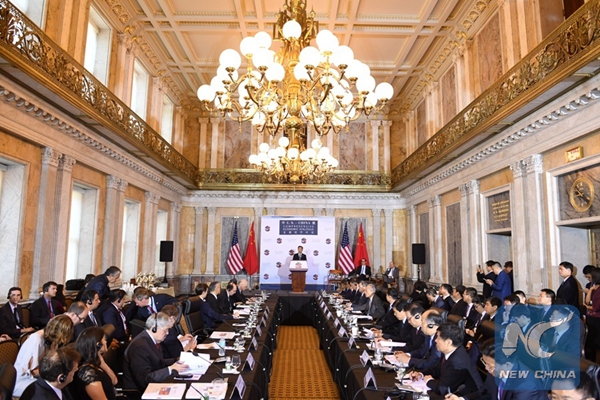US-China dialogue sees a new beginning
- By Sabena Siddiqui
 0 Comment(s)
0 Comment(s) Print
Print E-mail China.org.cn, July 21, 2017
E-mail China.org.cn, July 21, 2017
|
|
|
The first China-U.S. Comprehensive Economic Dialogue is held in Washington July 19, 2017. [Xinhua] |
At a higher point than seen in the recent past, U.S.-China relations have continued to move ahead positively, as seen in the first round of the China-U.S. Comprehensive Economic Dialogue.
Announced soon after the recent G20 Summit, these talks have re-affirmed the commitment by President Xi and President Trump to work together on healthy and stable economic ties, as global multi-polarity has encouraged the two major economic powers to adopt an inter-active stance.
Definitely a positive development, resumption of regular dialogue between the U.S. and China signals a more normal and secure relationship, even though China maintains a more broad-based, open approach while the U.S. still adheres to a more inward, inclusive stance.
The presidential talks in April decided to establish a mechanism consisting of four separate channels of communication. The Diplomatic and Security Dialogue was proposed as an upgraded version of the previous Strategic and Economic Dialogue. Enhancing this dialogue to focus on the main key strategic issues with more puissance, the plan was to hold this discussion first and separately from the other three dialogues to follow later this year.
On the finance and economy side, senior Trump administration officials would like to secure more American corporate access to China along with lessening barriers to sales of American products.
Commerce Secretary Wilbur Ross has said: "We must create more balance in our trade by increasing exports of made-in-America goods to China, and there are significant opportunities if we can work together to remove the significant barriers that exist."
Carrying forward this detailed dialogue in the presence of Trump son-in-law and senior presidential advisor Jared Kushner, gradual progress in resolving issues can be expected based on a realistic approach.
Vice Premier Wang Yang has urged an optimistic attitude, saying, "Dialogue cannot immediately address all differences, but confrontation will immediately damage the interests of both sides."
An encouraging step has been the re-opening of China’s market for enhanced American trade and some access to the financial services sector by America companies, and further ground will be covered in the current dialogue.
Longer-term trade and global concerns will be worked out through this new platform to address main issues like steel trade friction. High tariffs imposed on Chinese steel products seeking to enter the American market have undoubtedly hurt China's iron and steel enterprises.
Not only that, the biggest prevailing trade irritants still have to be sorted out, such as the demand that China cut excess capacity in steel and aluminium production, address the lack of broad access for U.S. firms to China's financial services market, and U.S. national security curbs on high-tech exports to China.
Addressing the chronic trade deficit with China remains the Trump administration’s top priority, but many other issues also need to be sorted out and synchronized to achieve the best results.
Commenting on the 100-day talks that have just ended, Douglas Paal, vice president for studies at the Carnegie Endowment for International Peace, believed, "The results so far to improve trade and investment appear to have been more constructive than many critics expected, [and it] is possible there will be further progress at the CED."
Regarding economic friction as a vibrant, healthy sign, Philipp Rösler, head of Regional and Government Engagement and member of the Managing Board of the World Economic Forum, recently observed: “Admittedly, there are discussions about frictions between the Chinese and American economies. However, it shouldn't be overlooked that the same discussions also exist between the E.U. and the U.S., concerning subsidies, dumping and airline access.
“Yet, they still have good relations, good trade relations in particular. What I would like to say is that negotiation is part of the normal relationship in business terms. Maybe sometimes there are tough discussions, but it's still part of normal negotiations….the entire picture shows a strong trade and business relationship and that's for the good."
Opening their markets in tandem, America and China have made a positive start which reflects the resolve of President Xi evident in his speech at the World Economic Forum in favor of global trade, as well as promotion of the Belt and Road Initiative.
Notwithstanding initial glitches, endless possibilities lie ahead if these two global economic powers wish to work together. There is always room for healthy competition even though the U.S. tends to focus more on the domestic scene.
Jacob Parker, vice president of China operations at the U.S.-China Business Council in Beijing, believes concentrated efforts are required to achieve a significant breakthrough, saying that what has appeared already "is an excellent momentum builder, but much more needs to be done for the commercial negotiations to be considered a success."
The author is a geopolitical analyst at think tank Katehon, Pakistan.
Opinion articles reflect the views of their authors, not necessarily those of China.org.cn.







Go to Forum >>0 Comment(s)